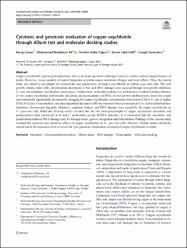| dc.contributor.author | Liman, Recep | |
| dc.contributor.author | Ali, Muhammad Muddassir | |
| dc.contributor.author | Ciğerci, İbrahim Hakkı | |
| dc.contributor.author | İstifli, Erman Salih | |
| dc.contributor.author | Sarıkürkçü, Cengiz | |
| dc.date.accessioned | 2022-04-27T07:58:48Z | |
| dc.date.available | 2022-04-27T07:58:48Z | |
| dc.date.issued | 15.04.2021 | en_US |
| dc.identifier.citation | Liman, R., Ali, M. M., Ciğerci, İ. H., İstifli, E. S., & Sarıkurkcu, C. (2021). Cytotoxic and genotoxic evaluation of copper oxychloride through Allium test and molecular docking studies. Environmental Science and Pollution Research, 28(33), 44998-45008. | en_US |
| dc.identifier.issn | 0944-1344 | |
| dc.identifier.issn | 1614-7499 | |
| dc.identifier.uri | https://doi.org/10.1007/s11356-021-13897-4 | |
| dc.identifier.uri | https://hdl.handle.net/20.500.12933/841 | |
| dc.description.abstract | Copper oxychloride gained great importance due to its broad-spectrum antifungal action to combat various fungal diseases of plants. However, excess quantity of cupric fungicides on plants causes enzymatic changes and toxic effects. Thus, the current study was aimed to investigate the cytotoxicity and genotoxicity of copper oxychloride on Allium cepa root cells. The root growth, mitotic index (MI), chromosomal aberrations (CAs), and DNA damage were assessed through root growth inhibition, A. cepa ana-telophase, and alkaline comet assays. Furthermore, molecular docking was performed to evaluate binding affinities of two copper oxychloride polymorphs (atacamite and paratacamite) on DNA. In root growth inhibition test, onion root length was statistically significantly decreased by changing the copper oxychloride concentration from lower (2.64±0.11 cm) to higher (0.92±0.12 cm). Concentration- and time-dependent decrease in MI was observed whereas increase in CAs such as disturbed anatelophase, chromosome laggards, stickiness, anaphase bridges, and DNA damage were caused by the copper oxychloride on A. cepa root cells. Molecular docking results revealed that the two main polymorphs of copper oxychloride (atacamite and paratacamite) bind selectively to G and C nucleotides on the B-DNA structure. It is concluded that the atacamite- and paratacamite-induced DNA damage may be through minor groove recognition and intercalation. Findings of the current study revealed the cytotoxic and genotoxic effects of copper oxychloride on A. cepa root cells. However, further studies should be carried out at the molecular level to reveal the cyto-genotoxic mechanism of action of copper oxychloride in detail. | en_US |
| dc.language.iso | eng | en_US |
| dc.publisher | Springer | en_US |
| dc.relation.isversionof | 10.1007/s11356-021-13897-4 | en_US |
| dc.rights | info:eu-repo/semantics/openAccess | en_US |
| dc.subject | Atacamite | en_US |
| dc.subject | Chromosomal aberrations | en_US |
| dc.subject | Mitotic index | en_US |
| dc.subject | DNA damage | en_US |
| dc.subject | Paratacamite | en_US |
| dc.subject | Molecular docking | en_US |
| dc.title | Cytotoxic and genotoxic evaluation of copper oxychloride through Allium test and molecular docking studies | en_US |
| dc.type | article | en_US |
| dc.authorid | 0000-0002-7944-4952 | en_US |
| dc.authorid | 0000-0001-7930-7782 | en_US |
| dc.authorid | 0000-0002-3626-7730 | en_US |
| dc.authorid | 0000-0003-2189-0703 | en_US |
| dc.authorid | 0000-0001-5094-2520 | en_US |
| dc.department | AFSÜ, Eczacılık Fakültesi, Temel Eczacılık Bilimleri Bölümü | en_US |
| dc.contributor.institutionauthor | Sarıkürkçü, Cengiz | |
| dc.identifier.volume | 28 | en_US |
| dc.identifier.issue | 33 | en_US |
| dc.identifier.startpage | 44998 | en_US |
| dc.identifier.endpage | 45008 | en_US |
| dc.relation.journal | Environmental Science and Pollution Research | en_US |
| dc.relation.publicationcategory | Makale - Uluslararası Hakemli Dergi - Kurum Öğretim Elemanı | en_US |
















